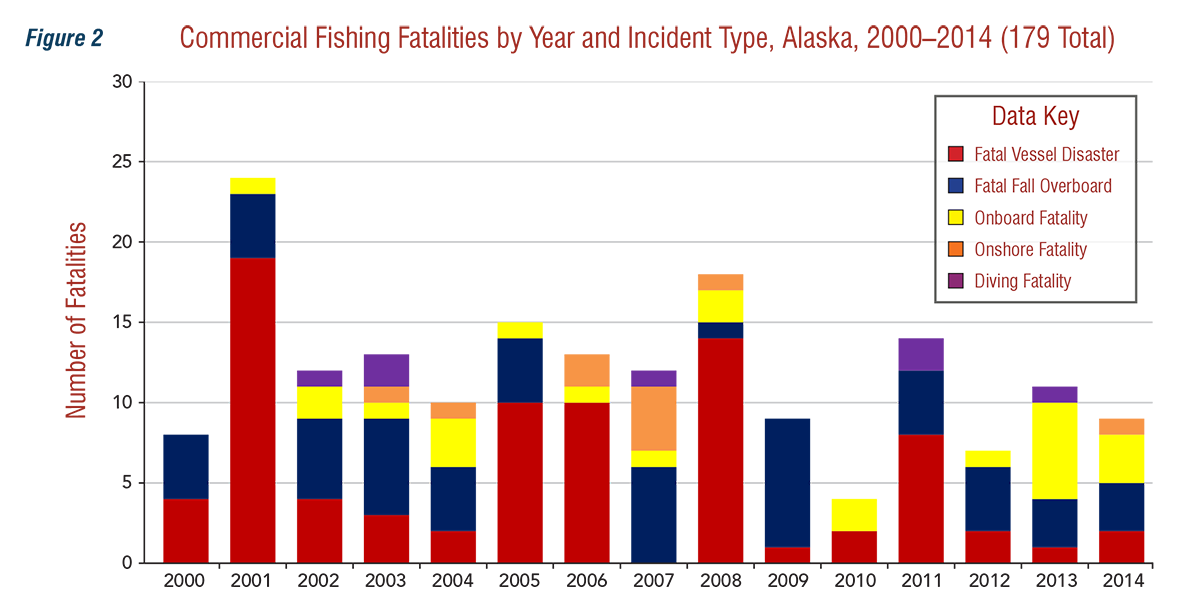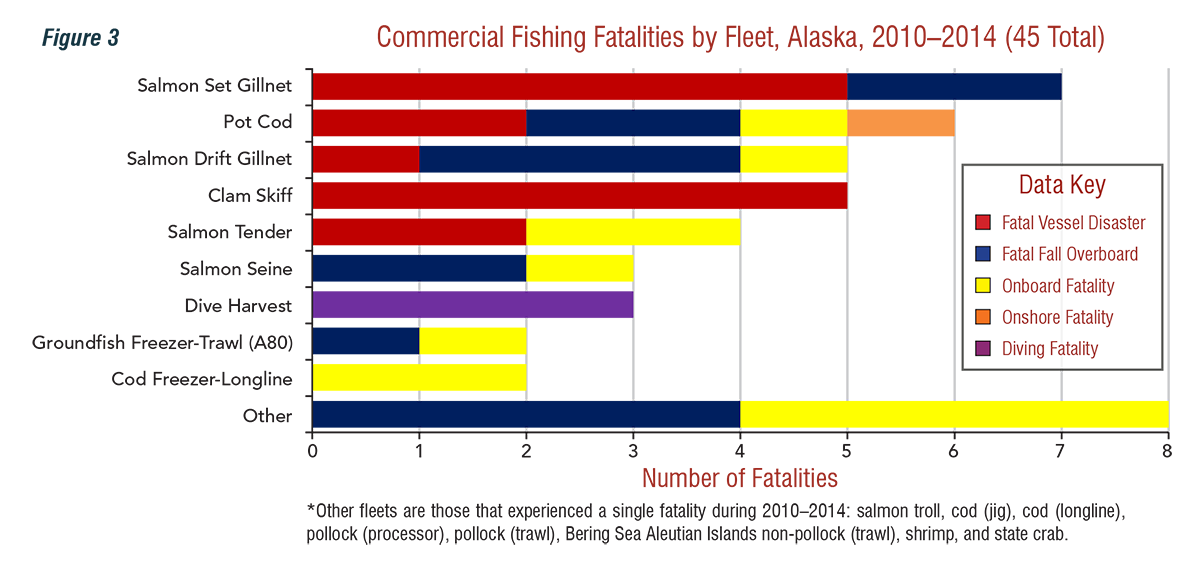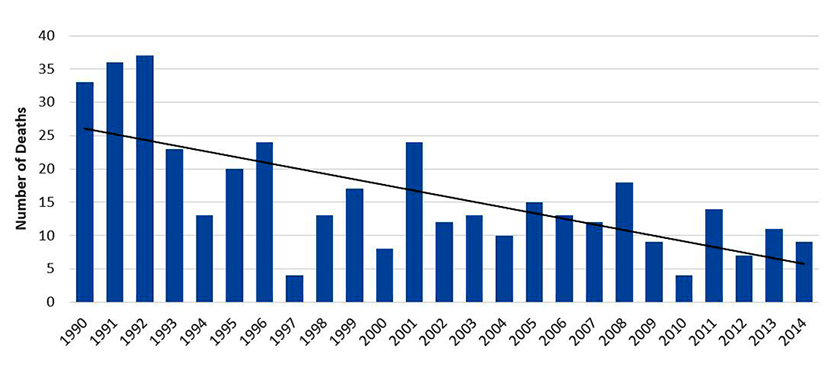COMMERCIAL FISHING SAFETY
Commercial Fishing Safety in Alaska

NIOSH has been researching commercial fishing safety in Alaska since the early 1990’s. Alaska’s commercial fishermen work in one of the world’s harshest environments and experience conditions that have a strong impact on their safety. One-third (399) of all work-related deaths that took place in Alaska during 1990—2014 occurred in the fishing industry. While commercial fishing remains a high-risk occupation nationally, the number of fishing fatalities due to traumatic injury in Alaska has decreased by 73% since the early 1990s (Figure 1). Safety improvements in Alaska occurred as a result of a combination of activities including safety regulations, and fishery-specific interventions focusing on unique hazards of each fishery.
Figure 1. Commercial Fishing Fatalities by Year, Alaska, 1990–2014 (399 Total)
During the 15-year period 2000–2014, 179 deaths occurred in Alaskan fisheries, averaging nearly 12 fatalities annually (Figure 2). During the first decade (2000–2009), 134 fatalities occurred, for an average of 13 deaths per year. For the most recent five-year period (2010–2014), 45 commercial fishing fatalities were recorded, averaging nine fatalities annually. Compared to the preceding 10-year period (2000–2009), this recent five-year period has shown a decrease in the frequency of deaths due to vessel disasters and an increase in the frequency of fatal onboard injuries. A slight decrease in the frequency of fatal falls overboard has also been observed; however, there was no change in the proportion of deaths due to falling overboard between the two periods.

Alaska Leading Hazards and Recommendations
Vessel Disasters
Vessel disasters are sinkings, capsizings, groundings, fires, or other events that force crews to abandon ship. Vessel disasters accounted for 33% of all deaths during 2010–2014, with most victims working in skiffs. The leading causes of fatal disasters were instability and being struck by large waves.
Recommendations:
- Take a marine safety class at least every five years.
- Conduct monthly drills for abandon ship, fire, and flooding.
- Ensure watertight integrity of the vessel.
- Maintain proper watch.
- Adhere to federal commercial fishing vessel safety regulations.
- Adhere to stability instructions (if applicable).
Falls Overboard
During 2010–2014, 14 crewmembers died from drowning after falling overboard, contributing to 31% of fatalities in the region. None of the fishermen were wearing a personal flotation device (PFD) when they drowned. Nearly half (43%) of the falls were not witnessed by other crewmembers, either because the fishermen were alone on the vessel (1) or alone on deck (5). Falls overboard were most frequently caused by loss of balance and tripping or slipping on deck.
Recommendations:
- Wear a PFD on deck.
- Use a man-overboard alarm system.
- Add effective recovery devices and re-boarding ladders.
- Conduct man-overboard drills monthly.
Onboard Fatalities
Of the 12 crewmembers who died from injuries sustained onboard vessels, three were due to unintentional drug overdoses and two were suicides. The remaining onboard fatalities involved two crewmembers becoming entangled in equipment, two asphyxiations in a confined space, two being struck by gear, and one who suffered severe chemical burns.
Recommendations:
- Install safety devices on deck machinery.
Alaska Fishing Fatalities by Fleet

The majority of fatalities (82%) occurred in nine Alaskan fleets (Figure 3).
Salmon
The salmon fishery experienced the highest number of fatalities with 20 deaths. Eight crewmembers died during vessel disasters, of which five were in the setnet fleet. An additional eight salmon fishermen died after falling overboard, distributed among drift gillnet, setnet, seine, and troll fleets. None of the crewmembers were wearing a personal flotation device (PFD) when they drowned.
Pot Cod
The pot cod fleet lost six crewmembers, mostly to vessel disasters and falls overboard. None of the crewmembers were wearing a personal flotation device (PFD) when they drowned.
Want to know more?
For more statistical information and detailed recommendations on how to keep you and your fellow crewmembers safe, open or download the full regional summary: Commercial Fishing Fatality Summary, Alaska Region (2010-2014)
For more information about other regions, visit our West Coast, Gulf of Mexico, and East Coast regional summary pages.
- Page last reviewed: July 19, 2017
- Page last updated: July 19, 2017
- Content source:
- National Institute for Occupational Safety and Health Office of the Director


 ShareCompartir
ShareCompartir
